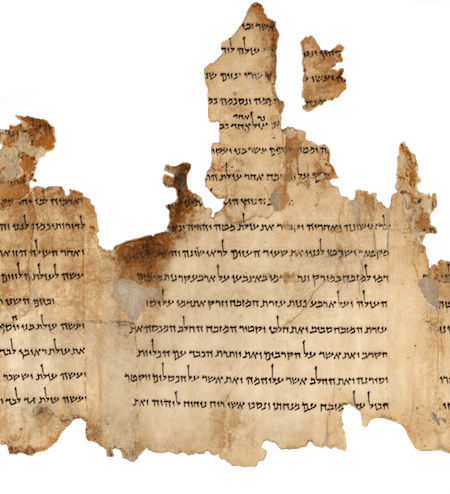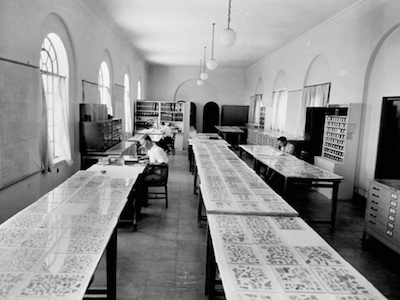Artifacts > Dead Sea Scrolls
The Dead Sea Scrolls are a collection of 981 different scrolls that were discovered between 1946 and 1956 in a series of eleven caves known as the Qumran Caves. The Qumran caves are located near the ancient city of Qumran in the West Bank and are about 2 km from the Dead Sea which is where the name comes from.
The Dead Sea Scrolls are extremely important because they provide the second oldest known copies of works that were later included in religious works such as the Hebrew Bible. The only two scrolls that are older than these are two silver ones exacavated from Jerusalem and date to around 600 BC.

Dead Sea Temple Scroll
The Dead Sea Scrolls are written in a variety of languages including ancient Hebrew, Aramaic, Greek and Nabataean. Other texts nearby are written in Latin from Masada and Arabic from Khirbet al-Mird. The texts are written on a variety of mediums from parchment to papyrus and even one on copper.

Dead Sea Scroll Text
It is believed that the Dead Sea Scrolls found in the Qumran Caves date to around 200 BC to 100 CE. There was bronze coins found at the site that have been attributed to John Hyrcanus (135–104 BC) and some are from around the First Jewish-Roman War (66–73 CE). These dates are also backed up by radiocarbon dating of the scrolls themselves.
These are not even the oldest scrolls recovered, just the sheer abundance is a magnificent find. There have been other scrolls recovered from between 700 BC and 1000 CE. Not all of the scrolls are in very good condition either. About 40% of them are copies of the Hebrew Bible, 30% are copies from the Second Temple Period and were not added into the Hebrew Bible.

Great Isiah Scroll - Dead Sea Scrolls
The texts that did not make it into the Hebrew Bible include the Book of Enoch, Jubilees, Book of Tobit, Wisdom of Sirach, Pslams 152-155. The remaining 30% of the scrolls are random documents that include information on particular groups within Judaism such as the Community Rule, War Scroll, Pesher on Habakkuk and the Rule of the Blessing.
The Dead Sea Scrolls are attributed with the Jewish sect known as the Essenes although other researchers believe they were written by priests in Jerusalem known as the Zadokites or other groups.
The Dead Sea Scrolls were discovered in a series of eleven caves known as the Qumran Caves near the archaeological site of Wadi Qumran. This site is located near the Dead Sea in Jordan and Israel. They were first discovered in 1946 by Bedouin sheperds. Between then and 1956 they were then studied initially by a team of archaeologists.

Dead Sea Scrolls Display
The initial discovery, by Bedouin shepherd Muhammed edh-Dhib, his cousin Jum'a Muhammed, and Khalil Musa, took place between November 1946 and February 1947.[12][13] The shepherds discovered seven scrolls (See Fragment and scroll lists) housed in jars in a cave near what is now known as the Qumran site. John C. Trever reconstructed the story of the scrolls from several interviews with the Bedouin. Edh-Dhib's cousin noticed the caves, but edh-Dhib himself was the first to actually fall into one. He retrieved a handful of scrolls, which Trever identifies as the Isaiah Scroll, Habakkuk Commentary, and the Community Rule, and took them back to the camp to show to his family. None of the scrolls were destroyed in this process, despite popular rumor.[14] The Bedouin kept the scrolls hanging on a tent pole while they figured out what to do with them, periodically taking them out to show people. At some point during this time, the Community Rule was split in two. The Bedouin first took the scrolls to a dealer named Ibrahim 'Ijha in Bethlehem. 'Ijha returned them, saying they were worthless, after being warned that they might have been stolen from a synagogue. Undaunted, the Bedouin went to a nearby market, where a Syrian Christian offered to buy them. A sheikh joined their conversation and suggested they take the scrolls to Khalil Eskander Shahin, "Kando", a cobbler and part-time antiques dealer. The Bedouin and the dealers returned to the site, leaving one scroll with Kando and selling three others to a dealer for 7 GBP (equivalent to US$29 in 2003, US$37 2014).[14] The original scrolls continued to change hands after the Bedouin left them in the possession of a third party until a sale could be arranged. (See Ownership.)In 1947 the original seven scrolls caught the attention of Dr. John C. Trever, of the American Schools of Oriental Research (ASOR), who compared the script in the scrolls to that of The Nash Papyrus, the oldest biblical manuscript then known, and found similarities between them. In March the 1948 Arab-Israeli War prompted the move of some of the scrolls to Beirut, Lebanon for safekeeping. On 11 April 1948, Millar Burrows, head of the ASOR, announced the discovery of the scrolls in a general press release.